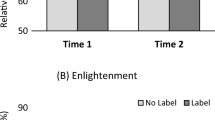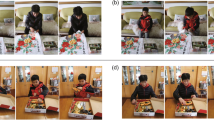Abstract
Research has indicated that existing stereotypic beliefs can produce systematic biases in the processing of information. Information which is consistent with stereotypic assumptions appears to be stored and/or retrieved with relative ease, leading to confirmatory biases in memory. The present study tested the hypothesis that behavior which is consistent with sex stereotypes would be judged to have occurred more frequently than nonsex-stereotypic behavior. Subjects were presented with a videotape consisting of behavioral episodes in which male and female actors engaged in sex-typed and neutral activities. Subjects then made frequency judgments and performed a recognition task. Although all activities were actually presented the same number of times, subjects' frequency estimates were significantly higher for sex-typed activity episodes. Implications for the maintenance of beliefs in sex stereotypes are discussed.
Similar content being viewed by others
References
Cantor, N., & Mischel, W. Traits as prototypes: Effects on recognition memory. Journal of Personality and Social Psychology 1977, 35 38–48.
Chapman, L. Illustory correlation in observational report. Journal of Verbal Learning and Verbal Behavior 1967, 6 151–155.
Chapman, L., & Chapman, J. The genesis of popular but erroneous psychodiagnostic observations. Journal of Abnormal Psychology 1967, 72 193–204.
Chapman, L., & Chapman, J. Illusory correlations as an obstacle to the use of valid psychodiagnostic signs. Journal of Abnormal Psychology 1969, 74 271–280.
Hamilton, D. L. The cognitive biases in the perception of social groups. In J. S. Carroll & J. W. Payne (Eds.), Cognition and social behavior. Hillsdale, N.J.: Erlbaum, 1976.
Hamilton, D. L., & Rose, T. L. Illusory correlation and the maintenance of stereotypic beliefs. Journal of Personality and Social Psychology 1980, 39 832–845.
Hepburn, C., & Locksley, A. A direct test of the “positive instance” hypothesis. Manuscript under editorial review, 1983.
Jenkins, H. M., & Ward, W. C. Judgment of contingency between responses and outcomes. Psychological Monographs 1979, 65 1–17.
Locksley, A., Borgida, E., Brekke, N., & Hepburn, C. Sex stereotypes and social judgment. Journal of Personality and Social Psychology 1980, 39 821–831.
Maccoby, E., & Jacklin, C. The psychology of sex differences. Stanford: Stanford University Press, 1974.
McKee, J. P., & Sheriffs, A. C. The differential evaluation of males and females. Journal of Personality 1957, 25 356–371.
Rogers, T. B., Rogers, P. J., & Kuiper, N. A. Evidence for the self as a cognitive prototype: The “false alarms” effect. Personality and Social Psychology Bulletin, 1979, 5 53–56.
Rothbart, M., Evans, M., & Fulero, S. Recall for confirming events: Memory processes and the maintenance of social stereotypes. Journal of Experimental Social Psychology 1979, 15 343–355.
Ruble, T. L. Sex stereotypes: Issues of change in the 1970s. Sex Roles 1983, 9 397–402.
Spence, J., & Helmreich, R. Masculinity and femininity. Austin: University of Texas Press, 1978.
Tavris, C., & Offir, C. The longest war: Sex differences in perspective. New York: Harcourt, 1977.
Tversky, A., & Kahneman, D. Availability: A heuristic for judging frequency and probability. Cognitive Psychology 1973, 5 207–232.
Author information
Authors and Affiliations
Additional information
The research reported in this manuscript was supported by NIH Grant BRSG RR07062 to Anne Locksley. The author was supported by a National Institute of Mental Health graduate student fellowship. Thanks are due to Anne Locksley for her advice throughout the project and to Michael Lenauer for his help in producing the videotape presentation.
Rights and permissions
About this article
Cite this article
Hepburn, C. Memory for the frequency of sex-typed versus neutral behaviors: Implications for the maintenance of sex stereotypes. Sex Roles 12, 771–776 (1985). https://doi.org/10.1007/BF00287870
Issue Date:
DOI: https://doi.org/10.1007/BF00287870




